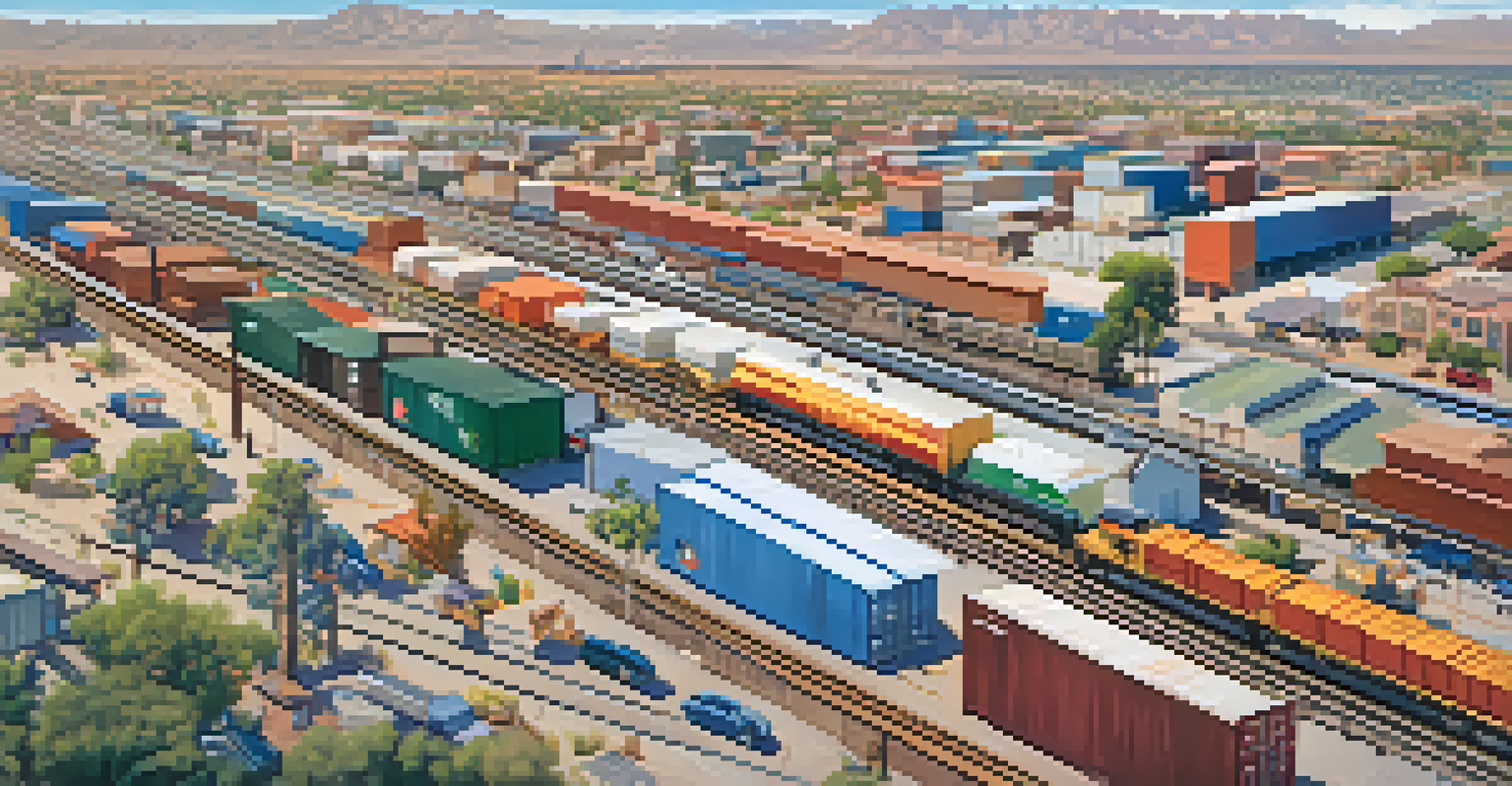The Role of Railroads in Arizona's Economic Growth

The Historical Significance of Railroads in Arizona
Railroads have played a pivotal role in shaping Arizona's history and economic landscape. The arrival of the Southern Pacific Railroad in the late 19th century marked a turning point, connecting remote areas to major markets. This development not only facilitated the movement of goods but also encouraged settlement and growth in previously inaccessible regions.
The railroad is a great equalizer, breaking down barriers of distance and time, and opening up new horizons for trade and prosperity.
By providing a reliable means of transportation, railroads helped establish vital supply chains for industries such as mining and agriculture. Towns sprang up along rail lines as people flocked to these new opportunities, creating a ripple effect that contributed to the state's burgeoning economy. The interconnectivity fostered by railroads laid the groundwork for Arizona's future economic expansion.
Today, the legacy of these early railroads can still be seen in Arizona's infrastructure and economic activities. They set the stage for modern transportation networks, influencing everything from local businesses to statewide economic policies. Understanding this historical context is crucial for appreciating the ongoing role of railroads in the state.
Railroads as Catalysts for Trade and Commerce
Railroads have consistently acted as catalysts for trade in Arizona, enhancing the state’s position as a key player in regional and national markets. By facilitating the swift movement of goods, railroads allow businesses to reach customers more efficiently, thereby boosting sales and profitability. This accessibility is particularly beneficial for industries like agriculture, where perishable goods need quick transport.

Additionally, railroads have attracted various businesses to set up operations near rail lines, creating jobs and stimulating local economies. For example, distribution centers often emerge in proximity to rail yards, allowing companies to streamline their logistics and reduce transportation costs. This clustering effect not only strengthens local economies but also enhances competitive advantages.
Railroads Drive Arizona's Economy
Railroads have historically facilitated trade and job creation, significantly boosting Arizona's economic landscape.
Moreover, the rail network supports cross-border trade with Mexico, positioning Arizona as a crucial hub for international commerce. As trade agreements evolve, the ability to efficiently transport goods across borders will only solidify the state's economic importance, making railroads indispensable to Arizona's ongoing growth.
The Role of Railroads in Job Creation
Job creation is one of the most significant economic impacts of railroads in Arizona. The construction and operation of rail lines generate thousands of jobs, ranging from engineering and construction to operations and maintenance. These jobs not only provide direct employment opportunities but also foster ancillary jobs in support industries like manufacturing and logistics.
Transportation is the backbone of economic growth, and railroads are one of the most efficient ways to move goods across vast distances.
Furthermore, the presence of railroads encourages the growth of industries that rely on freight transport, creating an ecosystem of employment opportunities. For instance, businesses in sectors such as mining and agriculture benefit from easier access to markets, leading to increased production and, consequently, more jobs. The multiplier effect of this job creation can significantly bolster local economies.
In addition to direct jobs, railroads also contribute to workforce development initiatives. Many rail companies offer training programs that equip workers with valuable skills, helping to prepare them for a variety of roles within the transportation sector. This investment in human capital ensures that Arizona has a skilled workforce ready to meet the demands of a growing economy.
Environmental Benefits of Rail Transportation
Railroads offer notable environmental benefits that contribute to sustainable economic growth in Arizona. By transporting goods over long distances, railroads are significantly more energy-efficient than trucks, reducing the overall carbon footprint of freight transport. This efficiency is crucial in a state that values its natural landscapes and strives for responsible development.
Additionally, railroads can help alleviate road congestion, leading to fewer emissions and less wear and tear on highways. This not only benefits the environment but also enhances public safety and reduces infrastructure costs for the state. In this way, railroads serve as an eco-friendly alternative to traditional freight transport methods.
Environmental Impact of Railroads
Rail transportation offers a more energy-efficient and eco-friendly alternative, helping to reduce Arizona's carbon footprint.
The commitment to sustainability is increasingly important for consumers and businesses alike, as environmental considerations shape purchasing decisions. By investing in rail infrastructure, Arizona can position itself as a leader in sustainable economic practices, attracting environmentally conscious businesses and residents.
Technological Innovations in Railroads
Technological advancements have transformed the railroad industry, significantly enhancing its efficiency and reliability. Innovations such as automated systems, GPS tracking, and predictive maintenance have revolutionized how goods are transported across Arizona. These technologies not only improve operational efficiency but also enhance safety and reduce costs for businesses.
Moreover, the integration of renewable energy sources, such as solar power, into railroad operations is becoming increasingly common. Arizona, with its abundant sunlight, is well-positioned to leverage solar energy for rail operations, further reducing the environmental impact. This forward-thinking approach aligns with broader trends toward sustainability in transportation.
As technology continues to evolve, railroads will likely remain at the forefront of transportation innovation. By adopting cutting-edge technologies, Arizona’s railroads can improve service quality, attract more freight business, and contribute to the overall economic vitality of the state.
Challenges Facing Arizona's Railroad Industry
Despite the many benefits railroads bring to Arizona's economy, they also face several challenges that could impact their future growth. One significant issue is infrastructure maintenance; aging rail lines require regular upkeep to ensure safety and efficiency. Without adequate investment in infrastructure, the quality of service could decline, potentially deterring businesses from using rail transport.
Another challenge is competition from other modes of transportation, particularly trucking. As e-commerce continues to grow, the demand for quick deliveries has led to increased reliance on trucks, which can often provide faster service for short distances. Railroads must find ways to compete, potentially by emphasizing their cost-effectiveness for long-haul transport while improving delivery times.
Future Growth and Sustainability
Investments in railroad infrastructure and technology position Arizona's railroads as a vital player in sustainable economic development.
Lastly, regulatory hurdles can also pose challenges for the railroad industry in Arizona. Navigating complex regulations and securing funding for projects can slow down necessary improvements and expansions. Addressing these challenges will be crucial for ensuring that Arizona’s railroad system remains competitive and continues to contribute positively to the state’s economy.
The Future of Railroads in Arizona's Economy
Looking ahead, the future of railroads in Arizona’s economy appears promising, fueled by ongoing investments and strategic planning. As the demand for freight transport continues to rise, railroads are poised to play an even more critical role in supporting economic growth. This aligns with broader trends in supply chain management, where businesses are increasingly seeking reliable and efficient transportation options.
Additionally, the state is actively investing in railroad infrastructure to enhance capacity and modernize operations. These improvements are not just about increasing efficiency; they are also aimed at fostering economic development in underserved areas. By connecting remote communities to major economic centers, railroads can help stimulate local economies and improve quality of life.

Moreover, as sustainability becomes a core value for consumers, railroads can market themselves as the greener option for freight transport. By emphasizing their environmental benefits and technological advancements, Arizona's railroads can attract businesses that prioritize sustainability, ensuring their relevance in a rapidly evolving economic landscape.